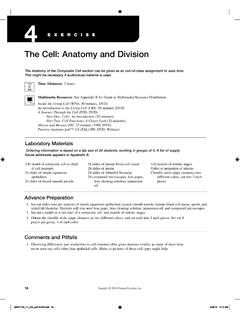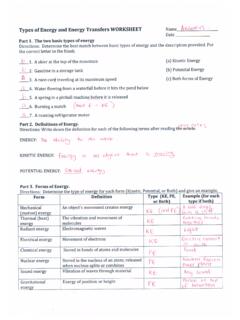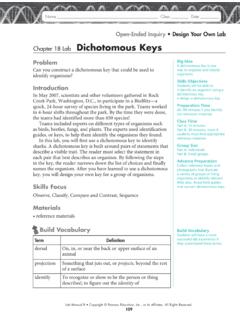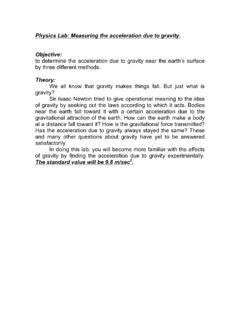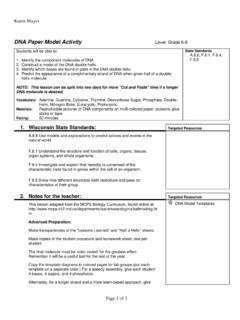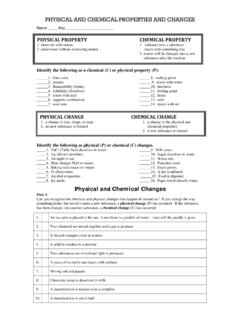Transcription of The Microscope - Holly H. Nash-Rule, PhD
1 12 Copyright 2014 Pearson Education, MicroscopeIf students have already had an introductory biology course in which the Microscope has been intro-duced and used, there might be a temptation to skip this exercise. I have found that most students need the review, so I recommend spending this time early in the course to make sure they are all comfortable with the Microscope , as it is used extensively throughout the laboratory Allotment: 2 :Bleach Solution, 10%Measure out 100 milliliters of household bleach. Add water to a final volume of 1 Blue Solution (Loeffler s)Weigh out gram methylene blue. Add 1 milliliter 1% potassium hydroxide solution, and 30 mil-liliters absolute ethanol to 100 milliliters distilled water. Warm the water to about 50 degrees C, stir in methylene blue; Saline (Mammalian, )Weigh out 9 grams of NaCl.
2 Add distilled/deionized water to a final volume of 1 liter. Make fresh just prior to MaterialsOrdering information is based on a lab size of 24 students, working in groups of 4. A list of supply house addresses appears in Appendix compound microscopes, lens cleaning solution, lens paper, immersion oil24 millimeter rulers24 slides of the letter e24 slides with millimeter grids24 slides of crossed colored threads (threads should cross at a single junction)Filter paper or paper towels1 box of Microscope slides1 box of coverslips1 box of flat-tipped toothpicks8 12 dropper bottles of physiologic saline8 12 dropper bottles of methylene blue stain (dilute) or iodine24 slides of cheek epithelial cells10% bleach solutionAutoclave bag, disposableAdvance Preparation 1. Provide each student with a compound Microscope , millimeter ruler, bottle of immersion oil, lens paper, and millimeter grid slide.
3 A supply of glass cleaner, such as Windex , should be available for lens cleaning. 2. Have available slides of the letter e and slides of crossed colored threads. Some instructors prefer to have slides for an entire semester available in individual boxes, which can be handed out to students. Others prefer to keep the slides on trays to be distributed as needed. 3. Set up an area for wet mount supplies, including clean Microscope slides and coverslips, flat-tipped tooth-picks, physiologic saline, methylene blue stain or iodine, and filter paper, or set out prepared slides of cheek epithelial 122/20/13 6:28 PM13 Exercise 3 Copyright 2014 Pearson Education, Inc. 4. Set up a disposal area containing a 1 liter beaker of 10% bleach solution and an autoclave bag. Note: Detailed instructions for treatment and disposal of materials used in labs involving human tissue and excretions are found in the preface of this Instructor s Guide.
4 5. If the microscopes are binocular rather than monocular, give additional instructions on After the parts of the Microscope have been identified, turn on the light and adjust the interpupillary distance so that a single circle of light is visible through the eyepieces. This is difficult for some students, usually because they are moving back and forth and changing their eye position. Have each student record his/her own interpupillary distance for later For a Microscope with an adjustable left eyepiece, focus the Microscope as directed, using the right eye Focus using the left eyepiece with the right eye closed. Both eyepieces should now be focused on the specimen. (Reverse the directions if the right eyepiece is adjustable.) 6. The directions for perceiving depth (p. 33) are for microscopes with objective lenses that advance and retract during focusing.
5 If the stage moves during focusing, the superior thread will come into focus first if these directions are followed. Alter instructions if and Pitfalls 1. Be sure to have the students check the orientation of the letter e on the slide before putting the slide on the Microscope . If they forget to check, they will miss the point of the exercise. 2. Beware of common focusing problems: dirty lenses, inverted slide, objective lens not securely in place, and wrong lens in position (oil immersion instead of high-power). 3. It is difficult to use a millimeter ruler to measure the working distance of the high-power and oil immer-sion lenses on some microscopes. A best estimate is usually sufficient. 4. Many students have difficulty with the section on determining the size of the Microscope field. The direct measurement is usually no problem, although some students measure area rather than diameter, and some students will have both the letter e slide and the grid on the stage at the same time.
6 Emphasize that direct measurement should be done using only one lens. Otherwise, measuring discrepancies cause confusion. The problem is often with the math involved. It is probably worthwhile to stop the class and work through the use of the formula (p. 32) when you see that most students are at this point in the exercise. 5. Clarify what is meant by detail observed in the chart on p. 31. 6. Students may forget safety precautions when preparing the wet mount. Emphasize the importance of fol-lowing directions for safe disposal of toothpicks and proper cleanup of glassware. 7. Many students forget to adjust the iris diaphragm and may end up using the light at its highest intensity, which is hard on the bulb. Remind students that the iris diaphragm should be adjusted so that the field is just filled with light when observed with the ocular lens removed.
7 In practice, it may be necessary to adjust the iris diaphragm for best contrast, although some resolution may be to Pre-Lab Quiz (p. 27) 1. d, stage 2. b, The slide should be almost in focus when changing to higher magnifications. 3. 350 4. c, with special lens paper and cleaner 5. 132/20/13 6:28 PM14 Exercise 3 Copyright 2014 Pearson Education, 2014 Pearson Education, to Activity QuestionsActivity 2: Viewing Objects Through the Microscope (pp. 29 31) 5. answers will vary depending on the lenses used. Working distance decreases as lens power increases. The e appears upside down and backwards. 6. The image moves toward you. The image moves to the right. 7. and 8. Grains begin to appear and are very visible with the high-power lens. The image is much larger. The entire e is visible with the low-power lens, but less than 1/4 of the letter is probably visible with the high-power lens.
8 The field is smaller. The object must be centered so that it falls into the field of the higher-power lens. The light to the field is reduced as the iris diaphragm is closed. The light intensity often must be increased when changing to a higher magnification, as the lens has a smaller diameter and therefore lets in less light. In practice, if the Microscope does not have a variable light intensity adjustment, the iris diaphragm should be adjusted to obtain the best contrast. 9. Grains are very visible. Yes. The working distance is less than that of the high-power lens. It is desirable to begin focusing with a low-power lens because the field is larger, making it easier to find the specimen on the slide, and the working distance is larger, reducing the chance of hitting the slide with the 3: Estimating the Diameter of the Microscope Field (pp.)
9 32 33) 3. answers depend on the field diameter of lenses used. For lenses with field diameters of millimeters, millimeter, and millimeter, respectively, the estimated lengths are about millimeters, millimeter, and millimeter. 4. No. The entire length of the object cannot be seen in one field. The estimate should be made with a lower-power objective 4: Perceiving Depth (p. 33) 2. When the stage descends, the first clearly focused thread is the bottom thread; the last clearly focused thread is the top one. answers depend on the order of the threads on the particular slides 5: Preparing and Observing a Wet Mount (pp. 33 34) 8. Most of the cells are separated from each other rather than in a continuous sheet. 10. A cheek epithelial cell is about 80 100 micrometers ( ) ( millimeter) in diameter.
10 They are more similar to those in Figure and easier to measure because they are in a continuous 142/20/13 6:28 PM15 Copyright 2014 Pearson Education, 2014 Pearson Education, MicroscopeName _____Lab Time/Date _____Care and Structure of the Compound Microscope 1. Label all indicated parts of the lensesRotating nosepieceObjective lensesStageMechanical stageIris diaphragm leverCondenserSubstage lightHeadArmPower switchLight controlCoarseadjustmentknobFineadjustmen tknobBase 2. Explain the proper technique for transporting the with two hands one supporting the base, the other holding the arm. 3 ExErcisErEviEw 152/20/13 6:28 PM16 Review Sheet 3 Copyright 2014 Pearson Education, 2014 Pearson Education, Inc. 3. The following statements are true or false. If true, write T on the answer blank.



